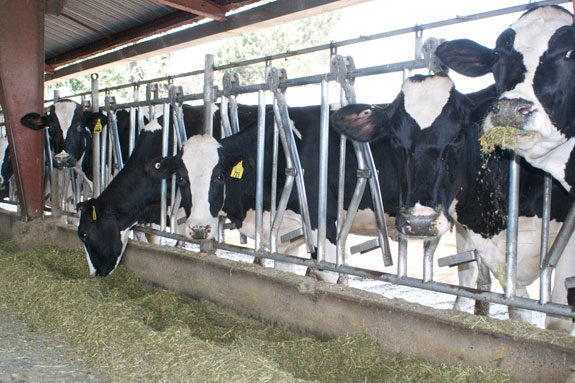New advancements in NIR (near infrared) technology are allowing dairy producers to precisely measure forage dry matter, fiber, starch and protein in real time right on the farm. In turn, dairy producers now have the opportunity to improve the way they feed cows.
The 2012 drought reminded many producers about the challenges of harvesting and feeding cows drought-stressed forages. NIR technology is a valuable tool to manage the wide variability that has resulted.
On-farm NIR forage analysis can provide information about forages in the field prior to harvest and as they are mixed into dairy rations without having to send samples off to the lab.NIR technology can enhance forage management:
- Test forage samples taken directly from the bunker or silo, or when harvesting in the field.
- Get real-time, immediate feed test results in under 60 seconds.
- NIR units are easy to use – test more often, as many times per day as desired, at no extra cost.
- Spot-test forage samples from different storage locations or in the field to get an average dry matter reading.
- Track dry matter and nutrient changes to predict future feeding programs and plan supplement use in advance.
- Monitor the quality of off-farm purchased hay, forage and byproducts.
- Same-day testing after a major rainfall measures changes in dry matter content, allows for dry matter adjustment at the TMR and avoids dips in production that can take days or weeks for the cow to recover.
Study compares on-farm NIR to oven method
Dr. Matt Akins, assistant professor of animal nutrition at the University of Wisconsin-Platteville, presented a paper “Evaluation of On-Farm Forage Dry Matter Determined by Near Infrared Spectroscopy” at the 2012 American Dairy Science Association National Meetings. The research study used the portable AgriNIR Portable Analyzer for Forages from dinamica generale US, Inc.
It concluded, “Overall, the on-farm NIRS measured dry matter content comparable to the oven method.”
The unit measures the percentage of dry matter, crude protein, starch, ADF, NDF, crude fat and ash in less than 60 seconds. It comes in a compact case that is easy to carry and transport. There is virtually no sample prep – hand-grab some feed and place it into the sample cup, then insert it into the unit. Results can be printed or transferred to a personal computer.
“I see real value in using NIR technology to measure drought-stressed forages both at harvest and during feedout of bunkers and bags, especially with corn silage,” says Akins.
He notes that there can be large differences in forage dry matter on bottom ground compared to high ground. The field variation translates into differences in bunkers and bags.
Bags can be particularly dramatic in dry matter differences from one end to the other since the loads of feed from the field are not layered like bunkers.
“With NIR technology, you are able to measure feed more often and get better understanding of what the variation can be,” says Akins. “It allows producers to make ration adjustments day to day or even batch to batch.”
A tool to avoid premature harvest
Using portable NIR technology, Dr. Akins worked with Green County UW-Extension Service agent Mark Mayer to help producers evaluate moisture content of drought-stressed corn.
“Producers were considering chopping corn in July to salvage a crop,” said Akins. “Upon sample analysis, most found that the corn plants were retaining moisture and too wet to harvest. This slowed the chopping down. Putting up corn silage that was too wet would have negatively affected fermentation.”
In August, more samples were evaluated in Green County. Akins noted that while the corn had dried down, less than half of the corn sampled was at an acceptable moisture range for harvest. The rest was about a week away from harvest.
“The NIR analysis was a huge benefit to these producers,” said Akins. “If they had harvested in July or early August the corn would have been much too wet. The result would have been reduced tonnage, poor fermentation and overall poor-quality corn silage in a year when every last bit of forage counted.”
In 2013, Dr. Akins and Dr. Randy Shaver from UW-Madison will use NIR technology to measure the nutritional values of corn silage, alfalfa silage and high-moisture corn and compare to a commercial NIR lab analysis.
“It does a very good job measuring dry matter and this will provide an even better idea of its benefit to producers,” added Akins.
Accurate calibrations
Calibration is key when it comes to using NIR technology at feedout. Portable units come preloaded with calibration curves for seven crop families including corn silage, hay, high-moisture corn, alfalfa hay, grass silage, TMR and soybean meal.
Accuracy is improved by sending samples into the lab for calibration. A good overall representation is needed from the bunker, bag or silo. Samples can be taken at different times over a few days to account for variations. Over the course of feedout, it is recommended that samples are sent to the lab periodically to verify the NIR unit’s accuracy. Calibrations are updated annually.
Dr. Akins concludes that NIR technology can be beneficial to any producer.
“Portable NIR technology is great for nutritionists or consultants. The payload mounted unit is more suited to the producer. It gives them more tools to manage their rations and it is a huge advantage to adjust TMRs on the fly.”
For more information about NIR technology, click here or phone (715) 781-7134 to contact Matt Dobberstein, sales and marketing, dinamica generale U.S.






